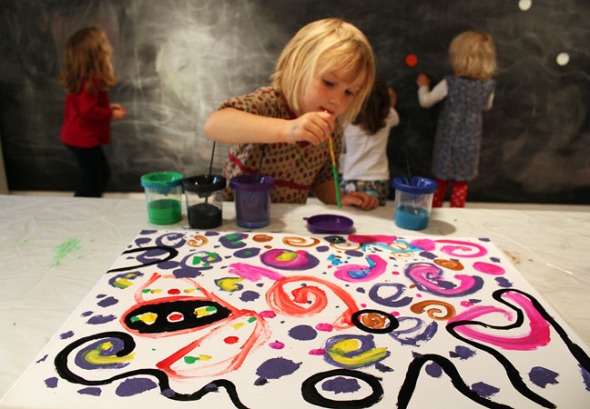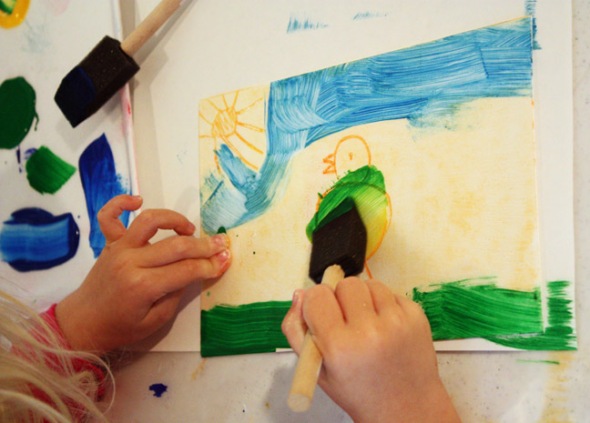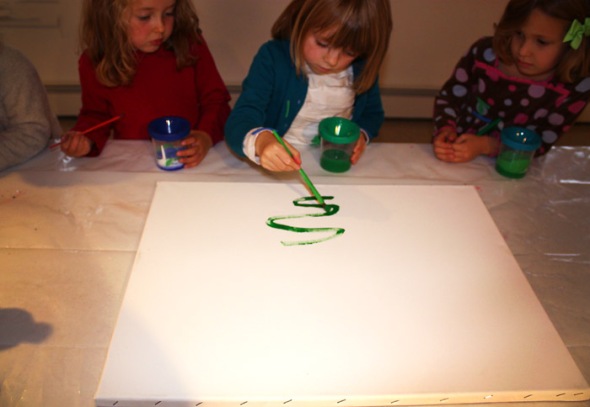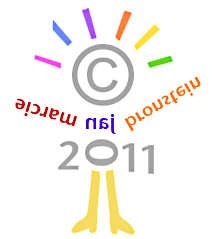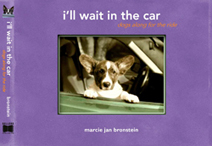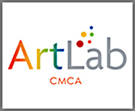collaborative painting : a mirror of a moment
Posted: 11/05/2011 Filed under: art, children, collaboration | Tags: collaboration, painting Leave a commentThis week in the ArtLab, I set out our second canvas for collaborative painting. The word collaborative (which means produced by two or more parties working together), is the right word to describe our project, but it doesn’t speak to or concern itself with “results.” I’m interested in group paintings for so many reasons, but the least of those reasons would be the physical, material outcome, or the painting itself. Yes of course, sometimes the paintings are really cool (even excellent), but this fades in comparison to what I think is the lasting value of the millions of micro-moments that take place between the painters, and between the painters and the painting itself.
After each child had chosen their color and the order in which they would paint, the child with purple paint made the first marks. Nothing was said about what would be painted or what the “plan” was. There was no plan.
The first child painted her purple swirls and then the second child immediately did the same, but in pink. Still, no one was speaking out loud. Everyone was simply watching…
The swirl theme continued with the third child making brown swirls, and then the fourth child making one red swirl. At that point, it seemed as if we lost the interest of the second child, who decided she wanted to take a nap. She went to the back of the room and began to lay down but instead decided to play with round magnets on the chalk board. Meanwhile, the child painting in red made a departure from the swirls and painted the red three-sectioned form you see above.
Thereafter followed dots and some more swirls by the other two children. They were completely engaged with what they were doing and with each other.
I then asked if I could take a turn, and chose black as my color. I added black lines, and made a point of continuing my lines down onto the sides of the canvas. No one chose to then paint on the sides of the canvas. But the young girl on the left asked to switch to my black paint.
We continued for quite awhile.
Colors were traded, green and blue were added to the mix, dots became looser marks that grew smaller and smaller.
Lots of giggling was taking place at the chalk board, and two more children decided to leave the painting and play with the magnets as well.
One child remained. She painted with all of the colors left behind.
monoprinting : a point of departure
Posted: 10/26/2011 Filed under: art, art education, children, classes, drawing | Tags: drawing, painting Leave a commentYesterday at the ArtLab, my five year olds drew on styrofoam sheets with wooden styluses to make monoprints. While so many aspects of this process were completely new for all of the students (drawing on foam, rolling with a brayer, pressing the foam onto the paper, burnishing with the back of a spoon), I spent very little time explaining or demonstrating technique. We dove right into the work and the materials.
After the first prints were pressed, the children began asking for more colors beyond the orange we had mixed. And it wasn’t long before they realized that their monoprints were simply paintings they were transferring to another surface. Their focus shifted to the painting of the styrofoam sheet…
…then the addition of more colors…experimenting with different ways of holding the brush…
…investigation into the effect of pressing paint into those carved lines…
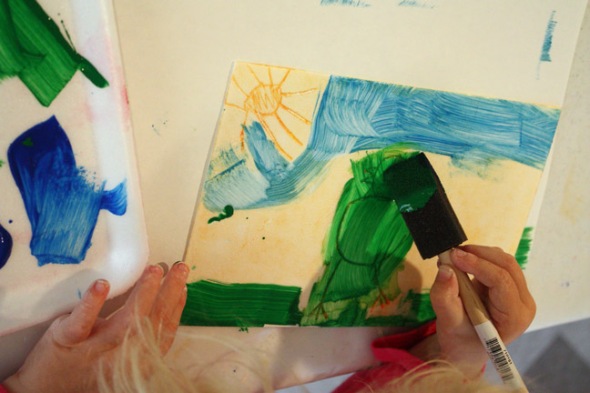
…until finally sponge brushes were traded for a carefully selected group of small paintbrushes.
At this point, it seemed clear that they were looking at the styrofoam sheets as “finished works.”
Each of these shifts in focus (refined choices) were initiated by the children, as they moved deeper and deeper into the process of making images by carving, exploring the materials, and coating the monoprint sheets. They themselves opened the doors to so many more projects: textural carved paintings, paintings created with different kinds of brushes, and of course, monoprint sheets that might not then make monoprints.
creative flow : power in a group
Posted: 10/23/2011 Filed under: collaboration, drawing, fotoplay, inspiration, mixed media, workshops | Tags: collaboration, drawing, fotoplay, painting, prompts, workshops Leave a commentYesterday’s Shake Up Your Art workshop at the Center For Maine Contemporary Art was fabulous. With a completely game group of adults, lots of art supplies, a great musical soundtrack, and fotoplay (a separate post on this coming soon!), a full collection of strange, funky, surprising work was made. We began as I often do in a workshop, with pencil on paper, moving in response to the sound of Bach:
Then we moved into crayon
and collaborative drawing and painting with a partner (in silence).
We made stamps based on a fragment of a newly-made painting
and then it wasn’t long before those same paintings and drawings were torn up as material for collage
and for those mesmerizing-to-work-on boxes:
At the end of the day, I too was shaken up… completely delighted by the work that had been created.
collaborative painting
Posted: 10/19/2011 Filed under: art, children, classes, collaboration | Tags: collaboration, painting Leave a commentFor our second autumn session in the ArtLab Studio, I set up a collaborative painting on canvas for my students. Each chose their color (some colors, like pink, we mixed, which of course is an event in itself) and then the children painted in turn, encouraged to give each other space and to take their time.
As the painting developed, they exchanged colors, brushes, and thoughts. They tried to guess what each was going to add to the painting. They talked about what they might paint next.
At a certain point, I suggested that we circle the painting and paint from both sides of the canvas. The change in perspective led to an even freer approach.

And finally the big question was posed to me: Who gets to take this painting home? This was actually the perfect question. My plan for my classes at the ArtLab Studio is above all, to create the sense of a working artist’s studio, where improvisation and experimentation drive the direction of the projects. I hadn’t planned on making a series of collaborative paintings on canvas, but the idea came as a result of the children’s enthusiasm for what they had made. So we would create at least three more paintings before the end of our session in December, and each child would have one to take home. Now, who will choose which?
the innocent eye
Posted: 10/18/2011 Filed under: art, artists, books, children, inspiration | Tags: artists, books, drawing, inspiration, painting Leave a commentThis is one of those books that never makes it back onto the shelf. It came into my studio many years ago, and while I’ve read each essay and studied each image numerous times, every reading is a revelation. (And an inspiration.) Jonathan Fineberg has spent his life exploring and writing about creativity, “interweaving four lifelong threads” into his work: psychoanalysis and neuroaesthetics, art history, child art and childhood, and his own creative practice, first in sculpture, now in film. Published in 1997, The Innocent Eye presented for the first time the collections of child art of many of our most beloved artists: Kandinsky, Miro, Klee, Dubuffet, Picasso and the CoBrA artists. We see the works of wondrous child-created art in the artists’ collections
 (from the collection of Dubuffet, 1940’s)
(from the collection of Dubuffet, 1940’s)
along with the work created by the artist himself:
We see how the artists regarded the works of their own children
 (Joan Miro so carefully and respectfully listening to his daughter Dolores in 1938.)
(Joan Miro so carefully and respectfully listening to his daughter Dolores in 1938.)
and we see the children’s works which so directly affected the artist’s vision.
 (created by Dolores Miro, 1942)
(created by Dolores Miro, 1942)
I mentioned in an earlier post my love for Karel Appel, one of the artists in the CoBrA (Copenhagen, Brussels, Amsterdam) collective. There is a wonderful selection of Appel’s work in The Innocent Eye, including this piece from 1948 entitled Animals of the Night
and this piece from 1950, The Questioning Child:









